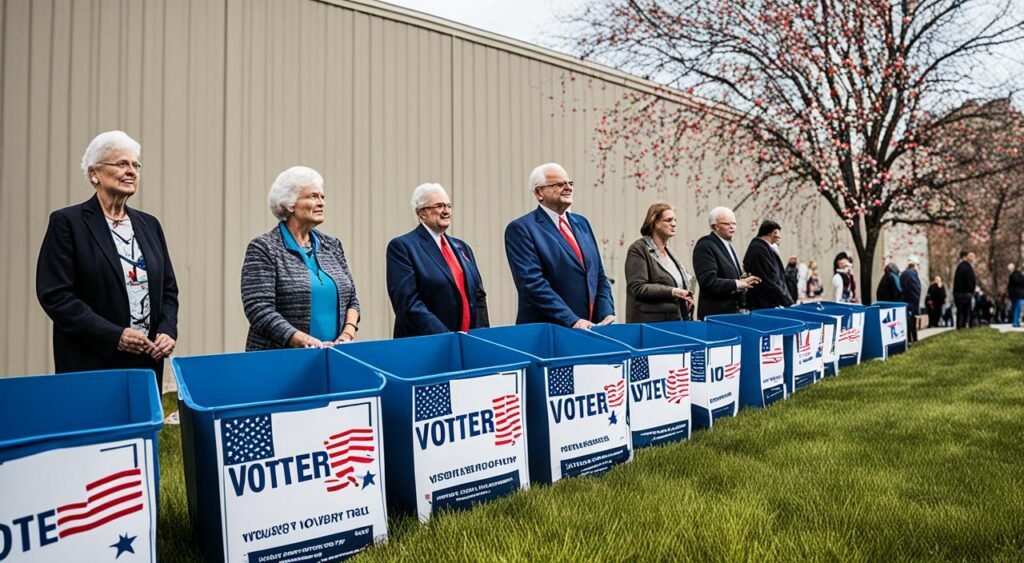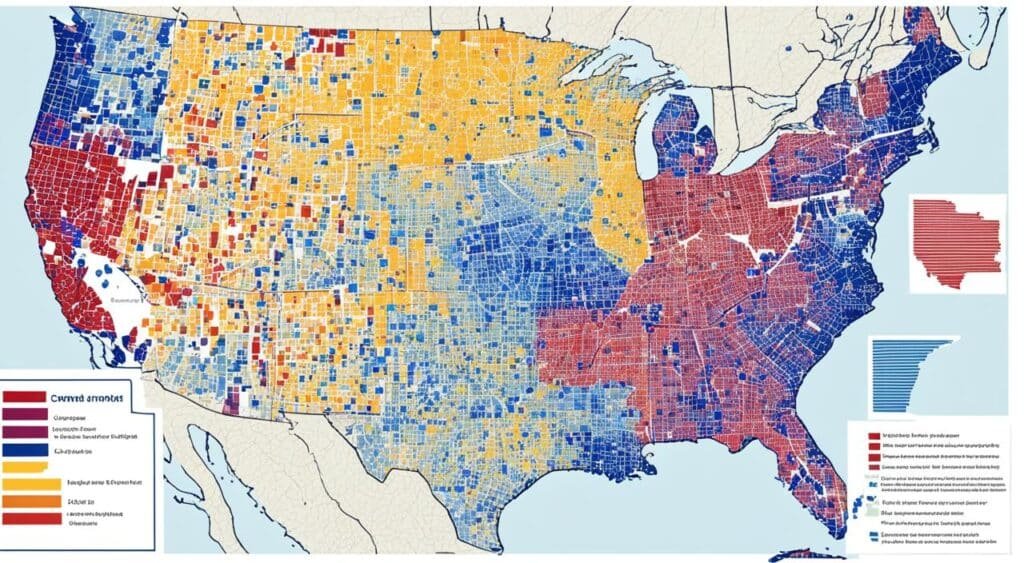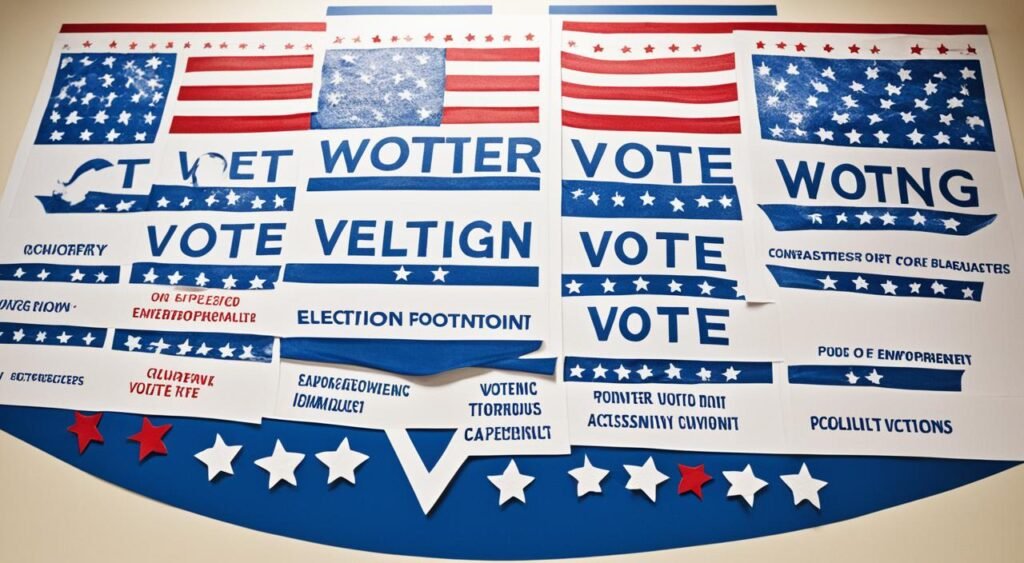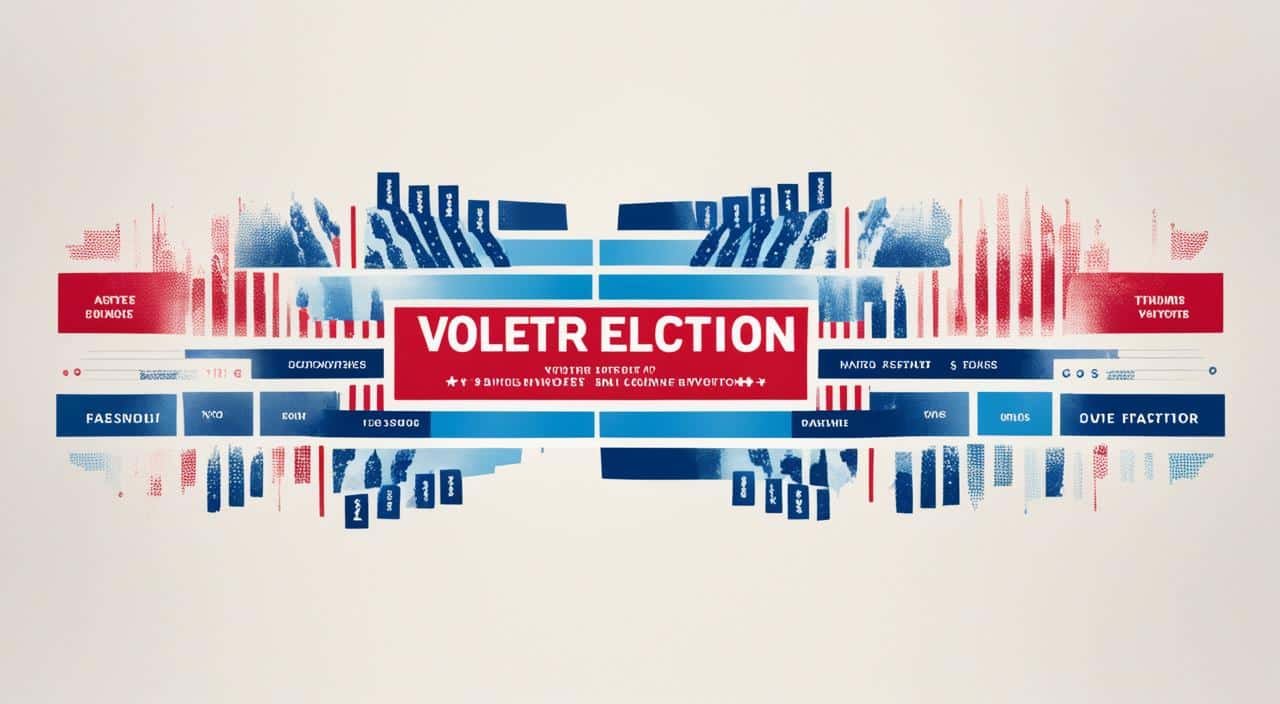Voter turnout matters a lot in elections. It shows how many people care enough to vote. Many things affect whether someone votes or not. These include how much money a person makes, their level of education, their age, and their background. The laws about voting and how well campaigns reach out to people also make a big difference.
Since many things can influence voting, it’s not the same for every election or place. But making sure everyone who can vote does, is key to a fair election. It’s also vital to fight against anything that stops people from voting, like unfair rules or discrimination.
Key Takeaways
- Voter turnout is a crucial indicator of the health and legitimacy of a democracy.
- Socioeconomic factors, such as income, wealth, and education, can significantly impact an individual’s likelihood to vote.
- Demographic factors, including age, race, ethnicity, and marital status, also play a crucial role in shaping voter turnout patterns.
- Political factors, such as voter registration laws and campaign mobilization efforts, can either facilitate or impede voter participation.
- Addressing issues of voter suppression and ensuring equitable access to the electoral process are crucial for promoting higher and more representative voter turnout.
Also Read : What Are The Benefits Of Global Education?
Understanding Voter Turnout
Voter turnout is key to the democratic process. It shows the percent of registered voters who vote in an election. In the United States, we figure this out by looking at the adult population. But, in places like Ireland, they use the count of registered voters.
This number is very important. It tells us a lot about how healthy and strong a democracy is. More people voting means citizens are more involved. It also means the government better represents the people.
Also Read : How Does Exercise Impact Immunity?
What is Voter Turnout?
Voter turnout is the percentage of registered voters who actually vote. It’s important because it shows how much people care about the elections. And it shows if the election results really mirror what people want. The way we calculate this can be different in each country.
Importance of Voter Turnout in Elections
How many people vote is super critical. It affects how fair and representative elections are. A lot of voters means the election is more likely to show what the people as a whole want.
But, if not many people vote, the results might not truly reflect the nation’s voice. To make sure democracy works as it should, getting a lot of people to vote is essential.
Also Read : How Should You Prepare For A Job Interview?
Key Factors Influencing Voter Turnout
Voter turnout varies due to many reasons, including income and education. It’s important to understand these factors. This knowledge helps us make plans to get more people involved in voting.
Socioeconomic Factors
Your income, wealth, and education affect how likely you are to vote. Those with more money and education often vote more. It shows we need to make voting fair for everyone, no matter their background.
Also Read : How Can I Plan Nutrition Meals?
Demographic Factors
Things like age, race, and if someone is married also shape voting habits. People between 18 and 29 don’t vote as much. But those over 65 often do. Some groups, like minorities, have had challenges voting. If someone is married or has kids, they’re usually more likely to vote.
Political Factors
The way politics works can make it easier or harder to vote. For example, some places make it too hard to register, which stops some people from voting. But, helping people understand elections and getting them excited to vote can increase turnout. We must ensure everyone can vote fairly to make voting better for everyone.
Also Read : What Is Interview Preparation And Why Is It Important?
Socioeconomic Factors

Income and wealth really shape voter turnout. Those with high incomes or lots of wealth are more likely to vote. This is true in the U.S. and all over the world. About 80% of people with high incomes vote. Only around 50% of those with lower incomes do the same.
Income and Wealth
Income and voter turnout clearly go hand in hand. People with more money tend to vote more. They have more resources and a strong belief in their ability to bring change. Their social connections also encourage them to participate in voting.
Education Level
Your education level also plays a key role in voter turnout. More education often means you’re more likely to vote. Research shows that getting more education actually encourages people to vote more. It’s a strong link.
The socioeconomic status and voting matter a lot. It points out the need to tackle inequality. Making sure everyone has an equal chance to participate in voting is crucial, no matter their background.
Demographic Factors
Age greatly affects voter turnout. Youths, aged 18-29, often vote less. In contrast, turnout is highest among people aged 65-74. So, age changes how likely someone is to vote. This shows how demographics can impact election participation.
In addition to age, race and voter turnout and ethnicity and voter turnout matter too. In the past, white Americans without Hispanic descent voted more. But things are changing. Now, more Hispanic and Black people are voting. This mix shows how who you are and your money status relate to voting.
If someone is married or has a family, they might vote more. This means married folks, especially those with kids, are more involved in elections. It looks like being with others through marriage or kids can make people want to vote. This shows the power of social connections and family on political activity.
Political Factors

Political factors like voter registration laws and campaign efforts can change voter turnout. If registration is hard, fewer people might vote, especially those with less money and minorities. People might not vote because of these tough laws.
But, making campaigns and voter turnout better can get more people to vote. Helping to make folks aware and making it easier to vote helps. Also, getting involved without taking sides and joining groups helps boost voting.
Political groups that focus on what makes voting hard and use smart ways to reach voters can really help. They work to break down barriers and get more people to vote.
Elections and Voter Turnout
The type of election can impact how many people vote. National elections usually see more people voting than local ones. In the U.S., Presidential elections have the largest voter turnout, with congressional and gubernatorial elections coming next. However, Local elections for positions like mayors or city councilors often get the fewest votes.
Voter turnout differences come from how important the position seems, the influence of campaigns, and the key issues. It’s vital for democracy that people vote, no matter the election’s level. This way, all areas of government truly represent the people they serve.
Presidential Elections
Presidential elections in the U.S. draw the most voters. This is because many feel the president is very important. Also, there’s a lot of talk about the elections, which gets people interested. These elections are key for making sure our leaders match what most people want.
Congressional and Gubernatorial Elections
Voter turnout in congressional and gubernatorial elections is less than what presidential elections get, but it’s still pretty good. These state-level elections might not get as much attention, but they are very important. They help decide the laws and policies that affect our daily lives.
Making sure people vote in these elections is important. This ensures that our state and federal representatives really listen to what the public wants.
Local Elections
Local elections usually get the fewest votes. Some areas see less than 10% of people casting a vote. Many factors play into this, such as thinking local issues aren’t important and not knowing much about the candidates.
However, local elections have a big impact on our daily lives. They decide things like our schools and roads. More people voting in local elections can make local government more in tune with our needs.
Geographic Variations in Voter Turnout

Voter turnout widely varies, influenced by geographic factors. This includes if an area is urban or rural or has broader regional differences.
Historically, rural areas see a higher voter turnout. They might have more community spirit, a lot of people owning homes, and polling places nearby.
But, the story changes based on where you look. In some urban working-class areas, turnout is surprisingly high. So, the situation is complex and not just about city or country living.
Urban vs. Rural Areas
Voter turnout can differ greatly between city and countryside. Rural places often have strong community bonds and more identification with taking part in elections.
Easier access to voting spots in the countryside might also boost their numbers. Yet, surprisingly, some city areas with many working-class people still manage to turn up to vote a lot.
So, the gap between city and country isn’t always clear cut.
Regional Differences
Some states and cities always show high or low voter turnout. Many things can sway these numbers, such as the political vibe, if elections are close, how strong community groups are, and who lives there.
It’s important to know these trends to better encourage voting. This can lead to fairer representation for all.
Voter Suppression and Disenfranchisement
Voter suppression and disenfranchisement lower voter turnout. They put up barriers to joining in politics. For instance, strict voter ID laws hit hard on those living in harder conditions. This includes people of color, the old, and those with lower income. They find it tough to vote. Then, there’s gerrymandering. It’s changing district borders to help certain political parties. This makes elections less fair and can make people not want to vote.
Felony disenfranchisement laws stop many from voting. This impacts people of color the most. Chance to vote is a right for everyone. So, fixing voter suppression problems is key. It means everyone can vote more easily. And that elections show what most people really want.
| Issue | Impact on Voter Turnout | Affected Groups |
|---|---|---|
| Voter ID Laws | Decreased turnout by creating barriers to voting | Racial minorities, the elderly, low-income individuals |
| Gerrymandering | Undermines representativeness of elections and discourages participation | Diverse communities across the political spectrum |
| Felony Disenfranchisement | Excludes large segments of the population from the electoral process | Communities of color |
Role of Technology and Social Media

Technology and social media are changing how people vote. Now, with online voter registration , signing up to vote is easier. This makes it simpler foryounger and more tech-savvy voters to take part.
Candidates use social media and digital ads to get their message out. They use sites like Facebook, Twitter, and Instagram to talk to voters. This helps make more people vote.
But, technology might not help everyone equally. It can make the gap between those who find it easy and those who don’t even bigger. It’s important to use tech wisely. We should use it to teach, help register, and get people to vote. But, we also need to watch out for problems it might cause.
Online Voter Registration
Signing up to vote has gotten easier because of the internet. This change is great for those who love using digital tools. It can help get more people to vote by making the start easy for everyone.
Social Media Campaigns
Today, politicians use social media to connect with voters. They send info, get people moving, and increase voting. But, social media can be tricky. It might share wrong stuff and make political problems worse. We need to be careful how we use it.
| Metric | Impact on Voter Turnout |
|---|---|
| Online Voter Registration | It makes voting easier, especially for those who like using the internet. This can mean more people vote. |
| Social Media Campaigns | They can get the word out and get people moving. But, they might also spread wrong info and make politics worse. |
We must use technology and social media the right way. It should help people learn, get ready to vote, and vote. But, we must also look out for things that could go wrong.
Also Read : Unraveling Just Plain Politics: Your Friendly Guide To Understanding
International Perspectives on Voter Turnout
Looking at how many people vote worldwide gives us great insights. Places like Australia have compulsory voting laws, making everyone vote. This leads to high voter participation rates. In countries where you choose to vote, like in many established democracies, fewer people do. But in emerging democracies, where fair elections are new, more people join in.
In established democracies, voting numbers can still vary a lot. For example, Switzerland and Portugal see fewer people voting than much of Europe. Learning about these global trends and what affects voting can help us spread awareness. This can improve how well we represent people in elections everywhere.
| Country | Voter Turnout in Developed Democracies | Voter Turnout in Developing Democracies |
|---|---|---|
| United States | 66.1% | N/A |
| United Kingdom | 67.3% | N/A |
| Germany | 76.2% | N/A |
| India | N/A | 67.4% |
| Brazil | N/A | 79.7% |
| South Africa | N/A | 65.9% |
Encouraging Higher Voter Turnout

Encouraging more people to vote is key to making our democratic system stronger. It ensures that the folks who choose the leaders really reflect our entire society. One big way to do this is by educating everyone about the voting process and its importance. Strategies to increase voter turnout often focus on talking to people and teaching them how to get involved.
Voter Education and Outreach
Teaching people about voting, whether in school or as adults, is crucial. When people understand why voting matters, they’re more likely to take part in elections. This education can come from groups or leaders who want everyone to be involved and informed.
Convenience Voting Options
Having different ways to vote makes it easier for everyone to participate. For example, you might have early voting or be able to vote by mail. These options mean more people can find a time that works for them to vote. It’s like removing obstacles that might keep someone from casting their vote.
Addressing Voter Apathy
Feeling like your vote doesn’t count or that politicians don’t care can lead to not wanting to vote at all. Tackling these problems is important for lighting that voting spark again. When people believe in the system and its fairness, they’re more likely to join in. It’s about making sure everyone feels their voice matters.
There are many ways to get more people involved in voting. By using a mix of strategies, leaders and communities can make sure voting is something almost everyone does. This way, our government truly represents the people.
Conclusion
Voter turnout is key for a good democracy. To get more people to vote, we need to understand what stops them. This includes things like money, where they live, and their view on politics.
We must fight against things that make voting hard. This could be because someone is trying to stop voters or some people are not allowed to vote. Through new tech and talking directly to people, we can get more to the ballot box. This strengthens our trust in elections.
Keeping people active and honest about voting is vital. It protects our strong and fair democracy. If we keep looking at what makes people not vote, we can make our system more open. This way, everyone’s views and needs in America can be heard.
FAQs
What is voter turnout?
Why is voter turnout important in elections?
What factors influence voter turnout?
How do socioeconomic factors impact voter turnout?
What demographic factors affect voter turnout?
How do political factors influence voter turnout?
How does the type of election affect voter turnout?
What geographic factors influence voter turnout?
How does voter suppression and disenfranchisement impact voter turnout?
What role do technology and social media play in voter turnout?
How do international perspectives inform our understanding of voter turnout?
What strategies can be used to encourage higher voter turnout?
Source Links
- https://callhub.io/blog/get-out-the-vote/what-affects-voter-turnout/
- https://www.khanacademy.org/humanities/us-government-and-civics/us-gov-political-participation/us-gov-voter-turnout/a/lesson-summary-voter-turnout
- https://www.maynoothuniversity.ie/research/spotlight-research/getting-out-vote-what-influences-voter-turnout





